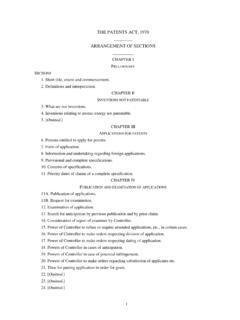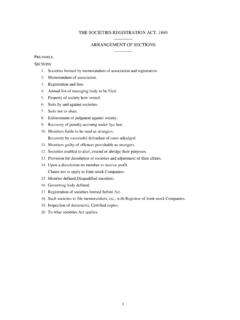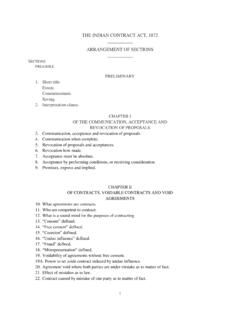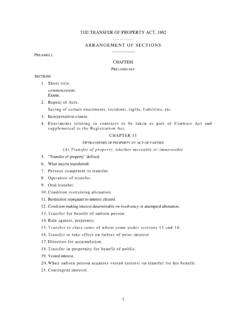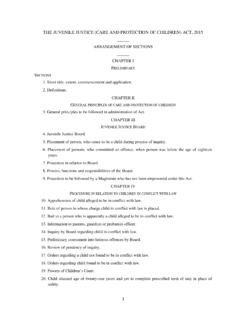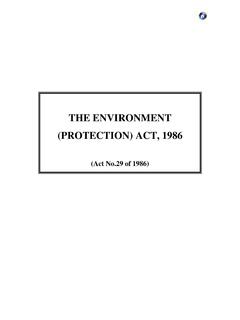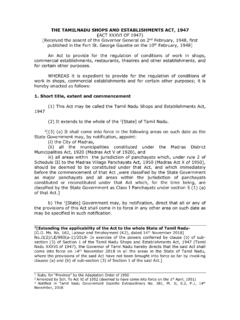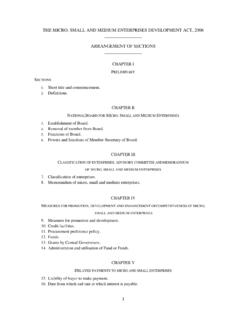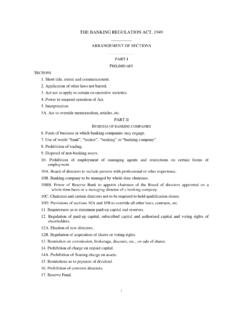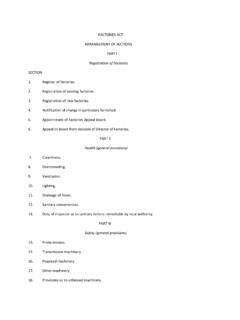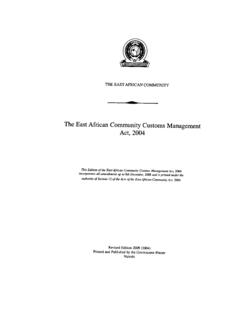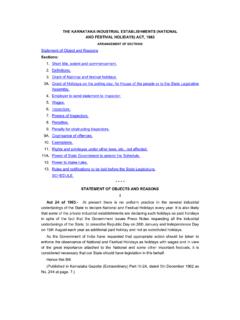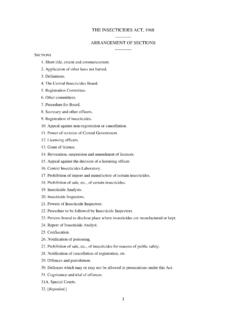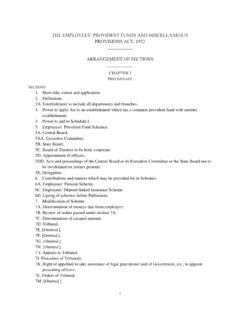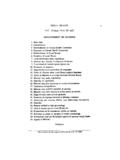Transcription of THE FACTORIES ACT, 1948
1 1 THE FACTORIES ACT, 1948 _____ arrangement OF SECTIONS _____ CHAPTER I PRELIMINARY SECTIONS 1. Short title, extent and commencement. 2. Interpretation. 3. References to time of day. 4. Power to declare different departments to be separate FACTORIES or two or more FACTORIES to be a single factory. 5. Power to exempt during public emergency. 6. Approval, licensing and registration of FACTORIES . 7. Notice by occupier. CHAPTER II THE INSPECTING STAFF 7A. General duties of the occupier. 7B. General duties of manufacturers, etc., as regards articles and substances for use in FACTORIES .
2 8. Inspectors. 9. Powers of Inspectors. 10. Certifying surgeons. CHAPTER III HEALTH 11. Cleanliness. 12. Disposal of wastes and effluents. 13. Ventilation and temperature. 14. Dust and fume. 15. Artificial humidification. 16. Overcrowding. 17. Lighting. 18. Drinking water. 19. Latrines and urinals. 20. Spittoons. CHAPTER IV SAFETY 21. Fencing of machinery. 22. Work on or near machinery in motion. 2 SECTIONS 23. Employment of young persons on dangerous machines. 24. Striking gear and devices for cutting off power. 25. Self-acting machines. 26. Casing of new machinery. 27. Prohibition of employment of women and children near cotton-openers. 28. Hoists and lifts. 29. Lifting machines, chains, ropes and lifting tackles.
3 30. Revolving machinery. 31. Pressure plant. 32. Floors, stairs and means of access. 33. Pits, sumps openings in floors, etc. 34. Excessive weights. 35. Protection of eyes. 36. Precautions against dangerous fumes, gases, etc. 36A. Precautions regarding the use of portable electric light. 37. Explosive or inflammable dust, gas, etc. 38. Precautions in case of fire. 39. Power to require specifications of defective parts or tests of stability. 40. Safety of buildings and machinery. 40A. Maintenance of buildings. 40B. Safety Officers. 41. Power to make rules to supplement this Chapter. CHAPTER IVA PROVISION RELATING TO HAZARDOUS PROCESSES 41A. Constitution of Site Appraisal Committees. 41B. Compulsory disclosure of information by the occupier.
4 41C. Specific responsibility of the occupier in relation to hazardous processes. 41D. Power of Central Government to appoint Inquiry Committee. 41E. Emergency standards. 41F. Permissible limits of exposure of chemical and toxic substances. 41G. Workers participation in safety management. 41H. Right of workers to warn about imminent danger. CHAPTER V WELFARE 42. Washing facilities. 43. Facilities for storing and drying clothing. 3 SECTIONS 44. Facilities for sitting. 45. First-aid appliances. 46. Canteens. 47. Shelters, rest rooms and lunch rooms. 48. Creches. 49. Welfare officers. 50. Power to make rules to supplement this Chapter. CHAPTER VI WORKING HOURS OF ADULTS 51. Weekly hours. 52. Weekly holidays.
5 53. Compensatory holidays. 54. Daily hours. 55. Intervals for rest. 56. Spread over. 57. Night shifts. 58. Prohibition of overlapping shifts. 59. Extra wages for overtime. 60. Restriction on double employment. 61. Notice of periods of work for adults. 62. Register of adult workers. 63. Hours of work to correspond with notice under section 61 and register under section 62. 64. Power to make exempting rules. 65. Power to make exempting orders. 66. Further restrictions on employment of women. CHAPTER VII EMPLOYMENT OF YOUNG PERSONS 67. Prohibition of employment of young children. 68. Non-adult workers to carry tokens. 69. Certificates of fitness. 70. Effect of certificate of fitness granted to adolescent.
6 71. Working hours for children. 72. Notice of periods of work for children. 73. Register of child workers. 74. Hours of work to correspond with notice under section 72 and register under section 73. 75. Power to require medical examination. 76. Power to make rules. 77. Certain other provisions of law not barred. 4 CHAPTER VIII ANNUAL LEAVE WITH WAGES SECTIONS 78. Application of Chapter. 79. Annual leave with wages. 80. Wages during leave period. 81. Payment in advance in certain cases. 82. Mode of recovery of unpaid wages. 83. Power to make rules. 84. Power to exempt FACTORIES . CHAPTER IX SPECIAL PROVISIONS 85. Power to apply the act to certain premises. 86. Power to exempt public institutions.
7 87. Dangerous operations. 87A. Power to prohibit employment on account of serious hazard. 88. Notice of certain accidents. 88A. Notice of certain dangerous occurrences. 89. Notice of certain diseases. 90. Power to direct enquiry into cases of accident or disease. 91. Power to take samples. 91A. Safety and occupational health surveys. CHAPTER X PENALTIES AND PROCEDURE 92. General penalty for offences. 93. Liability of owner of premises in certain circumstances. 94. Enhanced penalty after previous conviction. 95. Penalty for obstructing Inspector. 96. Penalty for wrongfully disclosing results of analysis under section 91. 96A. Penalty for contravention of the provisions of sections 41B, 41 C and 41 H.
8 97. Offences by workers. 98. Penalty for using false certificate of fitness. 99. Penalty for permitting double employment of child. 100. [Repealed.] 101. Exemption of occupier or manager from liability in certain cases. 102. Power of Court to make orders. 103. Presumption as to employment. 104. Onus as to age. 5 SECTIONS 104A. Onus of proving limits of what is practicable, etc. 105. Cognizance of offences. 106. Limitation of prosecutions. 106A. Jurisdiction of a court for entertaining proceedings, etc., for offence. CHAPTER XI SUPPLEMENTAL 107. Appeals. 108. Display of notices. 109. Service of notices. 110. Returns. 111. Obligations of workers. 111A. Right of workers, etc. 112. General power to make rules.
9 113. Powers of Centre to give directions. 114. No charge for facilities and conveniences. 115. Publication of rules. 116. Application of Act to Government FACTORIES . 117. Protection to persons acting under this Act. 118. Restrictions on disclosure of information. 118A. Restriction on disclosure of information. 119. Act to have effect notwithstanding anything contained in Act 37 of 1970. 120. Repeal and savings. THE FIRST SCHEDULE. THE SECOND SCHEDULE. THE THIRD SCHEDULE. 6 THE FACTORIES ACT, 1948 ACT NO. 63 OF 19481 [23rd September, 1948.] An Act to consolidate and amend the law regulating labour in FACTORIES . WHEREAS it is expedient to consolidate and amend the law regulating labour in FACTORIES ; It is hereby enacted as follows: CHAPTER I PRELIMINARY 1.
10 Short title, extent and commencement. (1) This Act may be called the FACTORIES Act, 1948. 2[(2) It extends to the whole of India 3**. (3) It shall come into force on the 1st day of April 1949. 2. Interpretation. In this Act, unless there is anything repugnant in the subject or context, (a) adult means a person who has completed his eighteenth year of age; (b) adolescent means a person who has completed his fifteenth year of age but has not completed his eighteenth year; 4[(bb) calendar year means the period of twelve months beginning with the first day of January in any year;] (c) child means a person who has not completed his fifteenth year of age; 5[(ca) competent person , in relation to any provision of this Act, means a person or an institution recognised as such by the Chief Inspector for the purposes of carrying out tests, examinations and inspection required to be done in a factory under the provisions of this Act having regard to (i) the qualifications and experience of the person and facilities available at his disposal.]]
